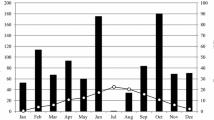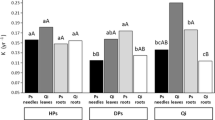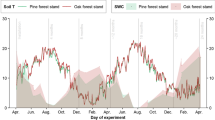Abstract
Species affect the dynamics of litter decay through the intrinsic properties of their litter, but also by influencing the environmental conditions imposed by their canopy, roots, and litter layers. We examined how human-induced changes in the relative abundances of two dominant Mediterranean trees—Pinus halepensis and Quercus calliprinos—impact leaf litter decomposition. A reciprocal transplant experiment tested decomposition of pine, oak, and mixed leaf litter in oak woodland and pine forest ecosystems with different relative abundances of pine and oak. Using likelihood methods, we tested the importance and magnitude of the environmental effects of local species abundance, litter layer composition, and soil properties on litter mass loss. Oak litter decomposition was slower than pine, and had an antagonistic effect on mixed litter decay. These results differ from other reported pine–oak associations, and are probably associated with a higher content of tannins and phenols in oak compared to pine litter in our study sites. The environmental effects of the two species were opposite to their litter decomposition dynamics. An increased proportion of pine in the oak woodlands and a higher content of pine needles in the litter layer of pine forests reduced decay rates. The presence of more oak and broadleaf litter in the litter layer accelerated decomposition in pine forests. Our results highlight the importance of considering multidimensional species effects mediated by both chemical and physical properties, and imply that man-made changes in the composition and configuration of plant communities may result in complex unpredicted consequences to ecosystem biogeochemistry.





Similar content being viewed by others
References
Adair EC, Parton WJ, Del Grosso SJ, Silver WL, Harmon ME, Hall SA, Burke IC, Hart SC (2008) Simple three-pool model accurately describes patterns of long-term litter decomposition in diverse climates. Glob Change Biol 14:2636–2660
Aerts R (1997) Climate, leaf litter chemistry and leaf litter decomposition in terrestrial ecosystems: a triangular relationship. Oikos 79:439–449
Aponte C, García LV, Pérez-Ramos IM, Gutiérrez E, Marañón T (2011) Oak trees and soil interactions in Mediterranean forests: a positive feedback model. J Veg Sci 22:856–867
Aranda V, Oyonarte C (2006) Characteristics of organic matter in soil surface horizons derived from calcareous and metamorphic rocks and different vegetation types from the Mediterranean high-mountains in SE Spain. Eur J Soil Biol 42:247–258
Arslan H, Guleryuz G, Kırmızı S (2010) Nitrogen mineralisation in the soil of indigenous oak and pine plantation forests in a Mediterranean environment. Eur J Soil Biol 46:11–17
Ashton IW, Hyatt LA, Howe KM, Gurevitch J, Lerdau MT (2005) Invasive species accelerate decomposition and litter nitrogen loss in a mixed deciduous forest. Ecol Appl 15:1263–1272
Austin AT, Vivanco L (2006) Plant litter decomposition in a semi-arid ecosystem controlled by photodegradation. Nature 422:555–558
Ayres E, Steltzer H, Simmons BL, Simpson RT, Steinweg JM, Wallenstein MD, Mellor N, Parton WJ, Moore JC, Wall DH (2009) Home-field advantage accelerates leaf litter decomposition in forests. Soil Biol Biochem 41:606–610
Baldrian P (2006) Fungal laccases—occurrence and properties. FEMS Microbiol Rev 30:215–242
Ball BA, Hunter MD, Kominoski JS, Swan CM, Bradford MA (2008) Consequences of non-random species loss for decomposition dynamics: experimental evidence for additive and non-additive effects. J Ecol 96:303–313
Berg B, Berg MP, Bottner P, Box E, Breymeyer A, Couteaux M, de Anta RC, Escudero A, Gallardo A, Kratz W, Madeira M, Malkonen E, McClaugherty C, Meentemeyer V, Munoz F, Piussi P, Remacle J, de Santo AV (1993) Litter mass loss rates in pine forests of Europe and Eastern United States: some relationships with climate and litter quality. Biogeochem 20:127–159
Berger TW, Berger P (2012) Greater accumulation of litter in spruce (Picea abies) compared to beech (Fagus sylvatica) stands is not a consequence of the inherent recalcitrance of needles. Plant Soil 358:349–369. doi:10.1007/s11104-012-1165-z
Blondel J (2006) The “design” of Mediterranean landscapes: a millennial story of humans and ecological systems during the historic period. Hum Ecol 34:713–729
Blondel J, Aronson J (1999) Biology and wildlife of the Mediterranean region. Oxford University Press, Oxford
Burnham KP, Anderson DR (2002) Model selection and multimodel inference: a practical information-theoretic approach. Springer, New York
Canham CD, Pacala SW (1995) Linking tree population dynamics and forest ecosystem processes. In: Jones CG, Lawton JH (eds) Linking species and ecosystems. Chapman and Hall, New York, pp 84–93
Canham CD, Uriarte M (2006) Analysis of neighborhood dynamics of forest ecosystems using likelihood methods and modeling. Ecol Appl 16:62–73
Cardinale BJ, Duffy JE, Gonzalez A, Hooper DU, Perrings C, Venail P, Narwani A, Mace GM, Tilman D, Wardle DA (2012) Biodiversity loss and its impact on humanity. Nature 486:59–67
Chapin III FS, Matson PA, Mooney HA (2011) Principles of terrestrial ecosystem ecology. Springer, New York
Chapman SK, Newman GS (2010) Biodiversity at the plant-soil interface: microbial abundance and community structure respond to litter mixing. Oecologia 162:763–769
Chazdon RL (2003) Tropical forest recovery: legacies of human impact and natural disturbances. Perspect Plant Ecol Evol Syst 6:51–71
Conn C, Dighton J (2000) Litter quality influences on decomposition, ectomycorrhizal community structure and mycorrhizal root surface acid phosphatase activity. Soil Biol Biochem 32:489–496
Cornelissen JHC, Perez-Harguindeguy N, Dıaz S, Grime JP, Marzano B, Cabido M, Vendramini F, Cerabolini B (1999) Leaf structure and defence control litter decomposition rate across species and life forms in regional floras on two continents. New Phytol 143:191–200
Cornwell WK, Cornelissen JHC, Amatangelo K, Dorrepaal E, Eviner VT, Godoy O, Hobbie SE, Hoorens B, Kurokawa H, Pérez-Harguindeguy N, Quested HM, Santiago LS, Wardle DA, Wright IJ, Aerts R, Allison SD, van Bodegom P, Brovkin V, Chatain A, Callaghan TV, Díaz S, Garnier E, Gurvich DE, Kazakou E, Klein JA, Read J, Reich PB, Soudzilovskaia NA, Vaieretti M, Westoby M (2008) Plant species traits are the predominant control on litter decomposition rates within biomes worldwide. Ecol Lett 11:1065–1071
Cortez J, Garnier E, Pérez-Harguindeguy N, Debussche M, Gillon D (2007) Plant traits, litter quality and decomposition in a Mediterranean old-field succession. Plant Soil 296:19–34
Coulis M, Hattenschwiler S, Rapior S, Coq S (2009) The fate of condensed tannins during litter consumption by soil animals. Soil Biol Biochem 41:2573–2578
Cox PM, Betts RA, Jones CD, Spall SA, Totterdell IJ (2000) Acceleration of global warming due to carbon-cycle feedbacks in a coupled climate model. Nature 408:184–187
Dan J, Fine P, Lavee H (2007) The soils of the land of Israel. Tel Aviv University, Eretz
De Fries RS, Foley JA, Asner GP (2004) Land-use choices: balancing human needs and ecosystem function. Front Ecol Environ 2:249–257
De Marco A, Spaccini R, Vittozzi P, Esposito F, Berg B, De Virzo Santo A (2012) Decomposition of black locust and black pine leaf litter in two coeval forest stands on Mount Vesuvius and dynamics of organic components assessed through proximate analysis and NMR spectroscopy. Soil Biol Biochem 51:1–15
Deaville ER, Flinn PC (2000) Near-infrared (NIR) spectroscopy: an alternative approach for the estimation of forage quality and voluntary intake (Chapter 15). In: Givens DI, Owen E, Axford REF, Omed HM (eds) Forage evaluation in ruminant nutrition. CAB International, Wallingford, pp 301–320
Dirks I, Navon Y, Kanas D, Dumbur R, Grunzweig JM (2010) Atmospheric water vapor as driver of litter decomposition in Mediterranean shrubland and grassland during rainless seasons. Glob Change Biol 16:2799–2812
Eckstein RL, Donath TW (2005) Interactions between litter and water availability affect seedling emergence in four familial pairs of floodplain species. J Ecol 93:807–816
Edwards AWF (1992) Likelihood, expanded edn. Johns Hopkins University Press, Baltimore
Eviner V (2004) Plant traits that influence ecosystem processes vary independently among species. Ecology 85:2215–2229
Fernández-Ondoño E, Rojo Serrano L, Jiménez MN, Navarro FB, Díez M, Martín F, Fernández J, Martínez FJ, Roca A, Aguilar J (2010) Afforestation improves soil fertility in south-eastern Spain. Eur J For Res 129:707–717
Foley JA, DeFries R, Asner GP, Barford C, Bonan G, Carpenter SR, Chapin FS, Coe MT, Daily GC, Gibbs HK, Helkowski JH, Holloway T, Howard EA, Kucharik CJ, Monfreda C, Patz JA, Prentice IC, Ramankutty N, Snyder PK (2005) Global consequences of land use. Science 309:570–574
Freschet GT, Aerts R, Cornelissen JHC (2012) Multiple mechanisms for trait effects on litter decomposition: moving beyond home-field advantage with a new hypothesis. J Ecol 100:619–630
Gabay O, Perevolotsky A, Bar Massada A, Carmel Y, Shachak M (2012) Differential effects of goat browsing on herbaceous plant community in a two-phase mosaic. Plant Ecol 212:1643–1653
Garcia-Pausas J, Casals P, Romanyà J (2004) Litter decomposition and faunal activity in Mediterranean forest soils: effects of N content and the moss layer. Soil Biol Biochem 36:989–997
Garnier E, Cortez J, Billès G, Navas ML, Roumet C, Debussche M, Laurent G, Blanchard A, Aubry D, Bellmann A, Neill C, Toussaint JP (2004) Plant functional markers capture ecosystem properties during secondary succession. Ecology 85:2630–2637
Gartner TB, Cardon ZG (2004) Decomposition dynamics in mixed-species leaf litter: a review. Oikos 104:230–246
Gelfand I, Grünzweig JM, Yakir D (2011) Slowing of nitrogen cycling and increasing nitrogen use efficiency following afforestation of semi-arid shrubland. Oecologia 168:563–575
Godoy O, Castro-Díez P, Van Logtestijn RSP, Cornelissen JHC, Valladares F (2010) Leaf litter traits of invasive species slow down decomposition compared to Spanish natives: a broad phylogenetic comparison. Oecologia 162:781–790
Gomez-Aparicio L, Canham CD (2008) Neighborhood models of the effects of invasive tree species on ecosystem processes. Ecol Monog 78:69–86
Gressel N, Inbar Y, Singer A, Chen Y (1995) Chemical and spectroscopic properties of leaf litter and decomposed organic matter in the Carmel Range, Israel. Soil Biol Biochem 27:23–31
Harmon ME, Lajtha K (1999) Analysis of detritus and organic horizons for mineral and organic constituents. In: Robertson GP, Coleman DC, Bledsoe CS, Sollins P (eds) Standard soil methods for long-term ecological research. Oxford University Press, New York, pp 143–165
Hättenschwiler S, Tiunov AV, Scheu S (2005) Biodiversity and litter decomposition in terrestrial ecosystems. Ann Rev Ecol Evol Syst 36:191–218
Hector A, Beale AJ, Minns A, Otway SJ, Lawton JH (2000) Consequences of the reduction of plant diversity for litter decomposition: effects through litter quality and microenvironment. Oikos 90:357–371
Heil M, Baumann B, Andary C, Linsenmair EK, McKey D (2002) Extraction and quantification of "condensed tannins" as a measure of plant anti-herbivore defence? Revisiting an old problem. Naturwissenschaften 89(11):519–524
Ibrahima A, Joffre R, Gillon D (1995) Changes in litter during the initial leaching phase: an experiment on the leaf litter of Mediterranean species. Soil Biol Biochem 27:931–939
Jones JB, Case VW (1990) Sampling, handling, and analyzing plant tissue samples. In: Westerman RL (ed) Soil testing and plant analysis, 3rd edn. Soil Science Society of America Inc., Madison, pp 389–427
Kaneko N, Salamanca N (1999) Mixed leaf litter effects on decomposition rates and soil arthropod communities in an oak–pine forest stand in Japan. Ecol Res 14:131–138
Karberg NJ, Scott NA, Giardina CP (2008) Methods for estimating litter decomposition. In: Hoover CM (ed) Field measurements for forest carbon monitoring—a landscape scale approach. Springer, New York, pp 103–111
Lambers H (1993) Rising CO2, secondary plant metabolism, plant–herbivore interactions and litter decomposition: theoretical considerations. Vegetatio 104(105):263–271
Landau S, Dvash L, Decandia M, Cabiddu A, Shapiro F, Molle G, Silanikove N (2004) Determination of poly(ethylene glycol) binding to browse foliage, as an assay of tannin, by near-infrared reflectance spectroscopy. J Agric Food Chem 52:638–642
Makkonen M, Berg MP, Handa IT, Hättenschwiler S, van Ruijven J, van Bodegom PM, Aerts R (2012) Highly consistent effects of plant litter identity and functional traits on decomposition across a latitudinal gradient. Ecol Lett 15:1033–1041
Milcu A, Manning P (2011) All size classes of soil fauna and litter quality control the acceleration of litter decay in its home environment. Oikos 120:1366–1370
Murphy L (2012) likelihood: methods for maximum likelihood estimation. R package version 1.3. http://CRAN.R-project.org/package=likelihood
Olsen SR, Cole CV, Watanabe FS, Dean LA (1954) Estimation of available phosphorus in soils by extraction with sodium bicarbonate. USDA Circ. 939. USDA, Washington, DC
Parton WJ, Scurlock JMO, Ojima DS, Gilmanov TG, Scholes RJ, Schimel DS, Kinyamario JI (1993) Observations and modeling of biomass and soil organic matter dynamics for the grassland biome worldwide. Glob Biogeochem Cycles 7:785–809
Rutigliano FA, D’Ascolia R, Virzo De Santo A (2004) Soil microbial metabolism and nutrient status in a Mediterranean area as affected by plant cover. Soil Biol Biochem 36:1719–1729
Sheffer E (2012) A review of the development of Mediterranean pine–oak ecosystems after land abandonment and afforestation: are they novel ecosystems? Ann For Sci 69:429–443
Sheffer E, Canham CD, Kigel J, Perevolotsky A (2013) Landscape-scale density-dependent recruitment of oaks in planted forests: more is not always better. Ecology 94:1718–1728
Sheffer E, Canham CD, Kigel J, Perevolotsky A (2014) An integrative analysis of the dynamics of landscape- and local-scale colonization of Mediterranean woodlands by Pinus halepensis. PloS One 9:e90178
Sparks DL (ed)(1996) Methods of soil analysis. Part 3: Chemical methods. SSSA Book Ser. 5. SSSA, Madison
Strayer DL (2012) Eight questions about invasions and ecosystem functioning. Ecol Lett 15:1199–1210. doi:10.1111/j.1461-0248.2012.01817.x
Tilman D, Reich PB, Isbell F (2012) Biodiversity impacts ecosystem productivity as much as resources, disturbance, or herbivory. Proc Natl Acad Sci USA 109:10394–10397
Van Wesemael B (1993) Litter decomposition and nutrient distribution in humus profiles in some Mediterranean forests in southern Tuscany. For Ecol Manage 57:99–114
Vivanco L, Austin AT (2008) Tree species identity alters forest litter decomposition through long-term plant and soil interactions in Patagonia, Argentina. J Ecol 96:727–736
Weber P, Bardgett RD (2011) Influence of single trees on spatial and temporal patterns of belowground properties in native pine forest. Soil Biol Biochem 43:1372–1378
Weedon JT, Cornwell WK, Cornelissen JHC, Zanne AE, Wirth C, Coomes DA (2009) Global meta-analysis of wood decomposition rates: a role for trait variation among tree species? Ecol Lett 12:45–56
Acknowledgments
We thank Eli Zaady and Jose Gruenzweig for their helpful advice. We would like to thank Ezra Moshe, Rafi Yonatan, Hagit Baram, Gabriel Cohen, Rachel and Israel Sheffer, Guy Mashiach and others for their help in the field experiment; and Levana Dvash, Rita Dumbor, and others for their help with the laboratory work and analyses. Finally, we thank Jose Gruenzweig, Gidi Ne’eman, the Hedin lab members, Sarah Hobbie, and three anonymous reviewers for helping us to improve this text. This work was funded by Nekudat Hen, the Israeli Science Foundation grant #514/10, and the Israel Forest Authority (KKL).
Author information
Authors and Affiliations
Corresponding author
Additional information
Communicated by Michael Madritch.
Electronic supplementary material
Below is the link to the electronic supplementary material.
Rights and permissions
About this article
Cite this article
Sheffer, E., Canham, C.D., Kigel, J. et al. Countervailing effects on pine and oak leaf litter decomposition in human-altered Mediterranean ecosystems. Oecologia 177, 1039–1051 (2015). https://doi.org/10.1007/s00442-015-3228-3
Received:
Accepted:
Published:
Issue Date:
DOI: https://doi.org/10.1007/s00442-015-3228-3




